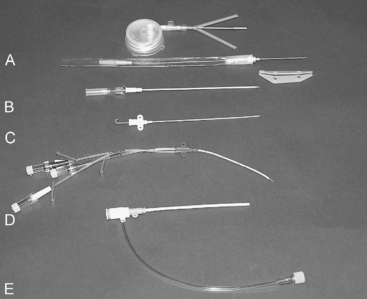Chapter 63 Central Venous Catheterization
INTRODUCTION
GENERAL CONCEPTS
Because introduction of foreign material or infectious agents into the central circulation can have far more serious consequences than peripheral vessel contamination, maintenance of aseptic technique when placing and using central venous catheters is of utmost importance (see Chapter 116, Catheter-Related Bloodstream Infection). General recommendations for central venous catheter maintenance is to wipe all injection ports with alcohol before needle puncture, keep insertion sites bandaged, prevent catheter hubs dragging on the ground, and immediately respond to witnessed catheter contamination. This may require cleaning and changing injection ports and fluid lines, or it may necessitate catheter removal. Inadvertent disconnection of fluid lines from a central venous catheter or animal-induced trauma to the catheter can lead to significant hemorrhage. Leaving ports of a central venous catheter open to the atmosphere places the patient at risk of air embolism. For this reason the catheter should be occluded by a catheter lock or manual kinking whenever the catheter hub is open to the atmosphere (e.g., when connecting and disconnecting syringes for blood aspiration).
CATHETER TYPES
Through-the-needle, long over-the-needle, long single-lumen, multilumen catheters, and catheter introducers can all be used to access central veins (Figure 63-1).1-3
Through-the-Needle
Through-the-needle catheters were discussed in Chapter 61, Peripheral Venous Catheterization. They commonly are used to catheterize jugular veins. The Drum-Cartridge is a very long through-the-needle catheter that is an effective PICC for large patients (see Figure 63-1).
Over-the-Needle
Over-the-needle catheters were discussed in Chapter 61, Peripheral Venous Catheterization. When used for jugular catheterization, they must be of a length appropriate for the patient’s size. The subcutaneous tissues in the region of the jugular vein are very loose, resulting in a lot of skin movement. Even though the catheter is well secured to the skin, short catheters can be pulled out of the vein easily.
Stay updated, free articles. Join our Telegram channel

Full access? Get Clinical Tree



